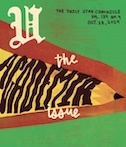A Pac-12 Bubble? The Logistics Seem Impossible
July 18, 2020
A return to sports as we’ve known them in the Fall 2020 semester is up in the air. On July 8, the Ivy League announced it was pushing all fall sports to the spring.
The likelihood of that happening in the Pac-12 seems low. Especially for football, which reportedly generated $20 million worth of revenue on media rights alone, while the University of Utah’s athletic department earned $99 million last year.
The financial downfall of football in the fall is just too much to bear, especially seeing that according to that report the university made $16 million off football ticket revenues last year, and with the growing pandemic, you would imagine that revenue will be gone with no fans in the stands.
But the chances of a regular football season seem low, especially as numerous conferences are opting to play a conference only schedule. How do you make it a reality? You take the approach of Major League Soccer and the National Basketball Association and create a bubble.
Where would the bubble be? The state of Washington seems like a good place. You would have the facilities of Washington, Washington State and of the Seattle Seahawks if necessary. You could feasibly play an in-conference schedule where you play all 11 other Pac-12 teams.
That would leave teams with an 11 game schedule instead of a nine game conference schedule which the Pac-12 is currently mulling over.
Is it a perfect solution virus-wise? No. But, the curve in Washington has been relatively flat recently — aside from the recent spike due to the 4th of July weekend. Washington though certainly provides a better option than spiking Arizona which also has the facilities capable of holding a bubble, the same can be said about Los Angeles.
Washington is the best case scenario for a bubble city currently speaking. The number one issue of course is that these are not professional athletes. They are students who are in college not only to participate in sports but also to gain an education. How do you overcome that hurdle?
Could colleges such as Washington and Washington State provide classes specifically for athletes? It seems like a reasonable proposition but also one that would take time and planning. That is one thing and one skill that the Pac 12 doesn’t seem to have at this moment in time. It is what makes this idea incredibly hard to pull off.
That seems unlikely though considering that Washington is moving 80% of its classes online this fall. Meanwhile, Washington State is taking the route of the University of Utah and reducing class sizes and running a hybrid program in the fall.
Where would students stay? Housing capacity at universities around the country is already being reduced. It would be costly to house student athletes in hotels the way MLS and NBA are currently working, and the time to develop travel plans is diminishing.
Three months ago it seems Pac-12 decision makers thought we would be in a much different spot than we are today. You can’t entirely blame them. Our current government doesn’t know how to handle this disease, so how are college commissioners going to know what to do? College athletics and sports leagues, in general, are great at doing two things — providing entertainment and printing money. They are not built to be governing health care providers.
Time is not on the side of the Pac-12 and college football. It will be really interesting to see what comes out of Pac-12 media day on July 29. If a bubble is going to happen, those conversations need to have started about a month ago, and at this point, that seems unlikely.
As for other fall sports, those seem in real jeopardy. Stanford discontinued 11 sports on July 8. Could you play all Pac 12 sports in a Washington bubble in the fall? The logistics seem impossible. One thing is for sure — a school with the deep pockets of Stanford has turned to cutting sports. We haven’t even heard about football yet, but if football does not happen, athletics in the Pac-12 are in an especially dire situation.












